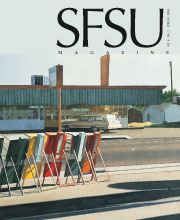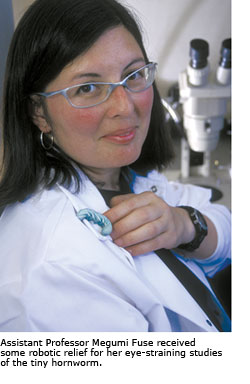 |
| |||
Recording every twitch and turn of 2-inch caterpillars as they shed their skin is enough to make even the most dedicated researcher squirm. But Assistant Professor of Biology Megumi Fuse and her students, who scrutinize insect behavior, have been aided by colleagues in the Computer Science Department. The collaboration is one of many already under way through SFSU’s new Center for Computing for Life Sciences (CCLS). Fuse and her students study how the neural system of the tobacco hornworm, actually a caterpillar, regulates itself during molts. The process, known as neuromodulation, is important for all species and essential to memory and perception in humans. Disruption of this process is associated with brain diseases such as Alzheimer’s and Parkinson’s. SFSU computer scientists Rahul Singh and Ilmi Yoon and their students collaborated with the Fuse lab to create a software program and 3-D world in which every neural nuance of this caterpillar’s molt was tracked, measured and noted as it wriggled out of its old skin. "Human eyes are very good at tracking," Singh says. "They can continue to track objects moving quickly or slowly, even if there are changes in the shape of the object or changes in lighting or even if the object is partly obscured." But this is tedious work that would be better served by what Singh calls "vision-based robotics." CCLS is part of a University-wide strategy to encourage and support interdisciplinary research and education. Dragutin Petkovic, chair of the Computer Science Department, points out that collaboration with industrial partners is a key component of the center. In June 2005 SFSU computer science and oceanography researchers teamed with Sun Microsystems and Agilent Technologies to produce the Networked Bay Environmental Assessment Monitoring System (NetBEAMS). The sensor-based system monitors and transmits oceanographic information such as salinity and temperature from remote locations at sea using wireless networks. Any scientist, commercial fisher or casual boater with a laptop or cell phone can now get the latest on San Francisco Bay conditions at www.netbeams.org. | ||||










 Wriggling Out of a Scientific Jam
Wriggling Out of a Scientific Jam